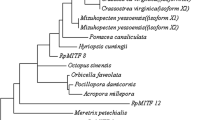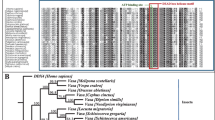Abstract
RNA interference (RNAi) is an effective approach for gene function analysis, which is well developed in mammal cell lines. However, RNAi has rarely been reported in marine bivalve species. To provide support on functional analysis of bivalve genes, for the first time to our knowledge, we conducted RNAi assay on primary cell of clam Meretrix meretrix in this study. Firstly we explored the method of culturing primary cells of M. meretrix to ensure the cells to live at high activity for at least 2 weeks. Ferritin gene was chosen as the target gene and RNAi assay was conducted through soaking the primary cells of M. meretrix digestive gland in medium containing dsRNA of ferritin gene. Realtime PCR, western blot and immunocytochemistry analysis were used to analyze the inhibition of gene expression after RNAi. Results showed the ferritin mRNA was significantly down-regulated by 66.11% after RNAi. Western blot result showed that the expression level of ferritin protein was also depressed post RNAi. The method developed in this study proved to be reliable and effective for RNAi assay on marine bivalve cells. It would be an efficient tool for gene function analysis in marine bivalves and more studies based on primary cells of marine bivalves can be expected.




Similar content being viewed by others
References
Lago-Leston A, Ponce E, Munoz M (2007) Cloning and expression of hyperglycemic (CHH) and molt-inhibiting (MIH) hormones mRNAs from the eyestalk of shrimps of Litopenaeus vannamei grown in different temperature and salinity conditions. Aquaculture 270(1–4):343–357
Wang X, Liu B, Wang G, Tang B, Xiang J (2008) Molecular cloning and functional analysis of cathepsin B in nutrient metabolism during larval development in Meretrix meretrix. Aquaculture 282(1–4):41–46
Zhang W, Wu C, Mai K, Chen Q, Xu W (2011) Molecular cloning, characterization and expression analysis of heat shock protein 90 from Pacific abalone, Haliotis discus hannai Ino in response to dietary selenium. Fish Shellfish Immun 30(1):280–286
Wang L, Wang Y (2011) Molecular characterization, expression patterns and subcellular localization of Myotrophin (MTPN) gene in porcine skeletal muscle. Mol Biol Rep 39(3):2733–2738
Celius T, Garberg P, Lundgren B (2004) Stable suppression of MDR1 gene expression and function by RNAi in Caco-2 cells. Biochem Biophys Res Commun 324(1):365–371
Coumoul X, Deng C (2006) RNAi in mice: a promising approach to decipher gene functions in vivo. Biochimie 88(6):637–643
Sarakul O, Vattanaviboon P, Wilairat P, Fucharoen S, Abe Y, Muta K (2008) Inhibition of α-globin gene expression by RNAi. Biochem Biophys Res Commun 369(3):935–938
Gonzalez-Gonzalez E, Lopezcasas P, Delmazo J (2008) The expression patterns of genes involved in the RNAi pathways are tissue-dependent and differ in the germ and somatic cells of mouse testis. BBA Gene Regul Mech 1779(5):306–311
Liu Y, Nie D, Huang Y, Lu G (2009) RNAi-mediated knock-down of gene mN6A1 reduces cell proliferation and decreases protein translation. Mol Biol Rep 36:767–774
Chen G, Qiao Y, Yao J, Jiang Q, Lin X, Chen F, Lin F, Lin M, Lin L, Zhu P (2011) Construction of NF-κB-targeting RNAi adenovirus vector and the effect of NF-κB pathway on proliferation and apoptosis of vascular endothelial cells. Mol Biol Rep 38:3089–3094
Filipowicz W (2005) RNAi: the nuts and bolts of the RISC machine. Cell 122(1):17–20
Cheng F, He S (2010) RNA interference: a potent technology in studying and modulating of dendritic cells, and potential in clinical therapy. Mol Biol Rep 37:2635–2644
Copf T, Rabet N, Averof M (2006) Knockdown of spalt function by RNAi causes de-repression of Hox genes and homeotic transformations in the crustacean Artemia franciscana. Dev Biol 298(1):87–94
Xu J, Han F, Zhang X (2007) Silencing shrimp white spot syndrome virus (WSSV) genes by siRNA. Antiviral Res 73(2):126–131
Priya TAJ, Li F, Zhang J, Yang C, Xiang J (2010) Molecular characterization of an ecdysone inducible gene E75 of Chinese shrimp Fenneropenaeus chinensis and elucidation of its role in molting by RNA interference. Comp Biochem Physiol B Biochem Mol Biol 156(3):149–157
Yazawa R (2005) Functional analysis of tumor necrosis factor gene promoter from Japanese flounder, Paralichthys olivaceus, using fish cell lines. Dev Comp Immun 29(1):73–81
Sahulhameed A, Parameswaran V, Shukla R, Brightsingh I, Thirunavukkarasu A, Bhonde R (2006) Establishment and characterization of India’s first marine fish cell line (SISK) from the kidney of sea bass (Lates calcarifer). Aquaculture 257(1–4):92–103
Hirota Y, Kurata Y, Kato M, Notsu T, Koshida S, Inoue T, Kawata Y, Miake J, Bahrudin U, Li P (2008) Functional stabilization of Kv1.5 protein by Hsp70 in mammalian cell lines. Biochem Biophys Res Commun 372(3):469–474
De Rosa S, De Caro S, Iodice C, Tommonaro G, Stefanov K, Popov S (2003) Development in primary cell culture of demosponges. J Biotechnol 100:119–125
Fan T, Wang X (2002) In vitro culture of embryonic cells from the shrimp, Penaeus chinensis. J Exp Mar Biol Ecol 267:175–184
Gao C, Sun J, Xiang J (2003) Primary culture and characteristic morphologies of medulla terminalis neurons in the eyestalks of Chinese shrimp, Fenneropenaeus chinensis. J Exp Mar Biol Ecol 290(1):71–80
Goswami M, Lakra WS, Rajaswaminathan T, Rathore G (2010) Development of cell culture system from the giant freshwater prawn Macrobrachium rosenbergii (de Man). Mol Biol Rep 37:2043–2048
Le Pennec G, Le Pennec M (2001) Acinar primary cell culture from the digestive gland of Pecten maximus (L.): an original model for ecotoxicological purposes. J Exp Mar Biol Ecol 259(1):171–187
Gong N, Li Q, Huang J, Fang Z, Zhang G, Xie L, Zhang R (2008) Culture of outer epithelial cells from mantle tissue to study shell matrix protein secretion for biomineralization. Cell Tissue Res 333(3):493–501
Van der Merwe M, Auzoux-Bordenave S, Niesler C, Roodt-Wilding R (2010) Investigating the establishment of primary cell culture from different abalone (Haliotis midae) tissues. Cytotechnology 62(3):265–277
Rinkevich B (1999) Cell cultures from marine invertebrates: obstacles, new approaches and recent improvements. J Biotechnol 70:133–153
Liu B, Dong B, Tang B, Zhang T, Xiang J (2006) Effect of stocking density on growth, settlement and survival of clam larvae, Meretrix meretrix. Aquaculture 258:344–349
Wang X, Liu B, Xiang J (2009) Cloning, characterization and expression of ferritin subunit from clam Meretrix meretrix in different larval stages. Comp Biochem Physiol B Biochem Mol Biol 154(1):12–16
Yao X, Zhang J, Sun J, Liu B (2011) Recombinant expression, characterization and expressional analysis of clam Meretrix meretrix cathepsin B, an enzyme involved in nutrient digestion. Mol Biol Rep 38:1861–1868
Yue X, Liu B, Sun L, Tang B (2011) Cloning and characterization of a hsp70 gene from Asiatic hard clam Meretrix meretrix which is involved in the immune response against bacterial infection. Fish Shellfish Immun 30(3):791–799
Yue X, Liu B, Xue Q (2011) An i-type lysozyme from the Asiatic hard clam Meretrix meretrix potentially functioning in host immunity. Fish Shellfish Immun 30(2):550–558
Yao X, Sun J, Zhang Q, Liu B (2011) Characterization of recombinant expression and tissue expression of ferritin in clam Meretrix meretrix. Oceanol Limnol Sin 42(6):863–867 (in Chinese with English abstract)
Livak K, Schmittgen T (2001) Analysis of relative gene expression data using realtime quantitative PCR and the 2−ΔΔCT method. Methods 25:402–408
Tirasophon W, Roshorm Y, Panyim S (2005) Silencing of yellow head virus replication in penaeid shrimp cells by dsRNA. Biochem Biophys Res Commun 334(1):102–107
Poncet J, Serpentini A, Boucaud-Camou E, Lebel J (2002) Cryopreservation of mantle dissociated cells from Haliotis tuberculata (Gastropoda) and postthawed primary cell cultures. Cryobiology 44:38–45
Li F, Wang D, Li S, Yan H, Zhang J, Wang B, Zhang J, Xiang J (2010) A Dorsal homolog (FcDorsal) in the Chinese shrimp Fenneropenaeus chinensis is responsive to both bacteria and WSSV challenge. Dev Comp Immun 34(8):874–883
Shao S, Sun Y, Li X, Zhang W, Fu B, Yun D, Zuo M (2008) The reversion effect of the RNAi-silencing mdr1 gene on multidrug resistance of the leukemia cell HT9. Cell Biol Int 32(8):893–898
Xia X, Zhou H, Ding H, Affar el B, Shi Y, Xu Z (2003) An enhanced U6 promoter for synthesis of short hairpin RNA. Nucl Acids Res 31(17):100–105
Huppi K, Martin S, Caplen N (2005) Defining and assaying RNAi in mammalian cells. Mol Cell 17(1):1–10
Bennasser Y, Le S, Benkirane M, Jeang K (2005) Evidence that HIV-1 encodes an siRNA and a suppressor of RNA silencing. Immunity 22(5):607–619
Soñanez-Organis JG, Racotta IS, Yepiz-Plascencia G (2010) Silencing of the hypoxia inducible factor 1-HIF-1-obliterates the effects of hypoxia on glucose and lactate concentrations in a tissue-specific manner in the shrimp Litopenaeus vannamei. J Exp Mar Biol Ecol 393(1–2):51–58
Wang X, Feng S, Zhang H, Wang Y, Cui Y, Wang Z, Liu J, Zou W (2011) RNA inference-mediated caveolin-1 down-regulation decrease estrogen receptor alpha (ERa) signaling in human mammary epithelial cells. Mol Biol Rep 38:761–768
Ogawa Y (2003) Immunocytochemistry of myoepithelial cells in the salivary glands. Prog Histochem Cyto 38(4):343–426
Nichol H, Locke M (1999) Secreted ferritin subunits are of two kinds in insects molecular cloning of cDNAs encoding two major subunits of secreted ferritin from Calpodes ethlius. Insect Biochem Mol Biol 29:999–1013
Geiser D, Shen M, Mayo J, Winzerling J (2009) Iron loaded ferritin secretion and inhibition by CI-976 in Aedes aegypti larval cells. Comp Biochem Physiol B Biochem Mol Biol 152(4):352–363
Acknowledgments
This work was financially supported by NSFC (31072249) and National Basic Research Program of China (2010CB126403).
Author information
Authors and Affiliations
Corresponding author
Rights and permissions
About this article
Cite this article
You, Y., Huan, P. & Liu, B. RNAi assay in primary cells: a new method for gene function analysis in marine bivalve. Mol Biol Rep 39, 8209–8216 (2012). https://doi.org/10.1007/s11033-012-1668-y
Received:
Accepted:
Published:
Issue Date:
DOI: https://doi.org/10.1007/s11033-012-1668-y




